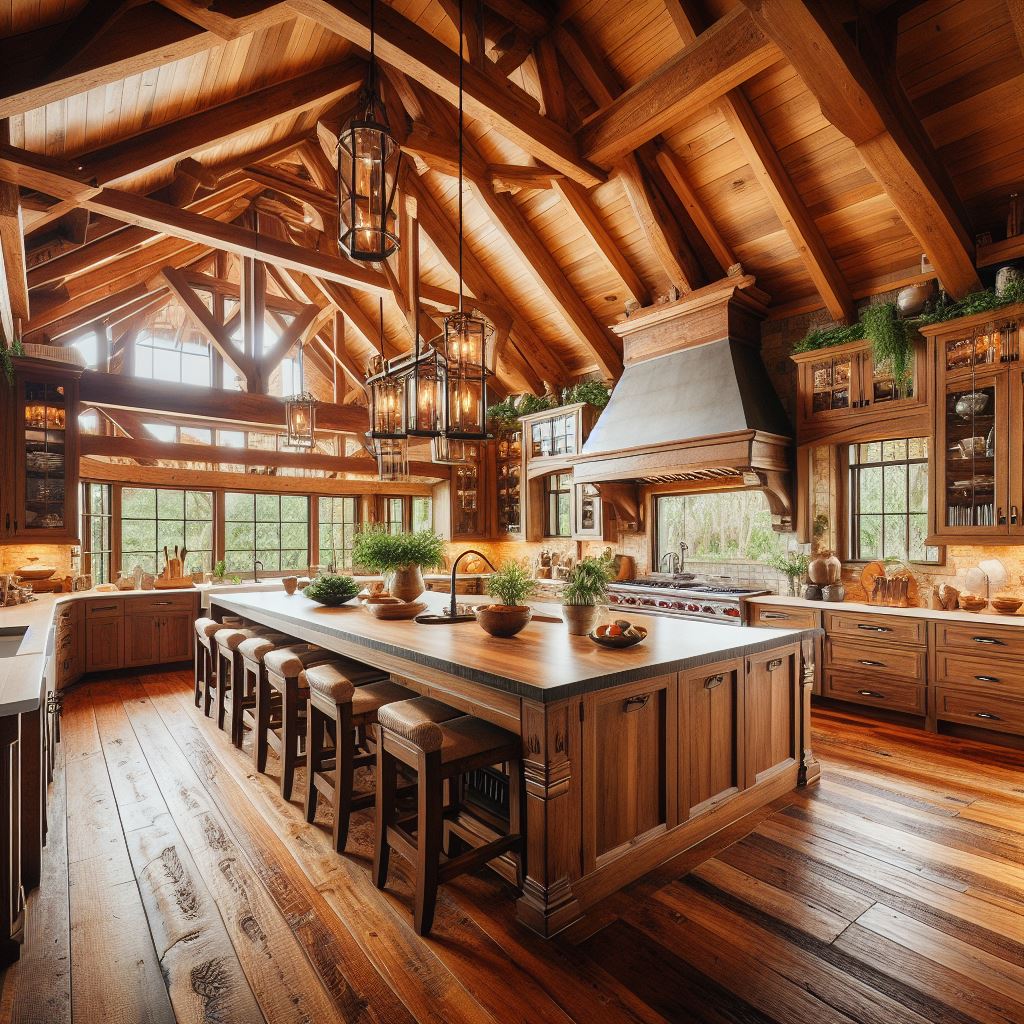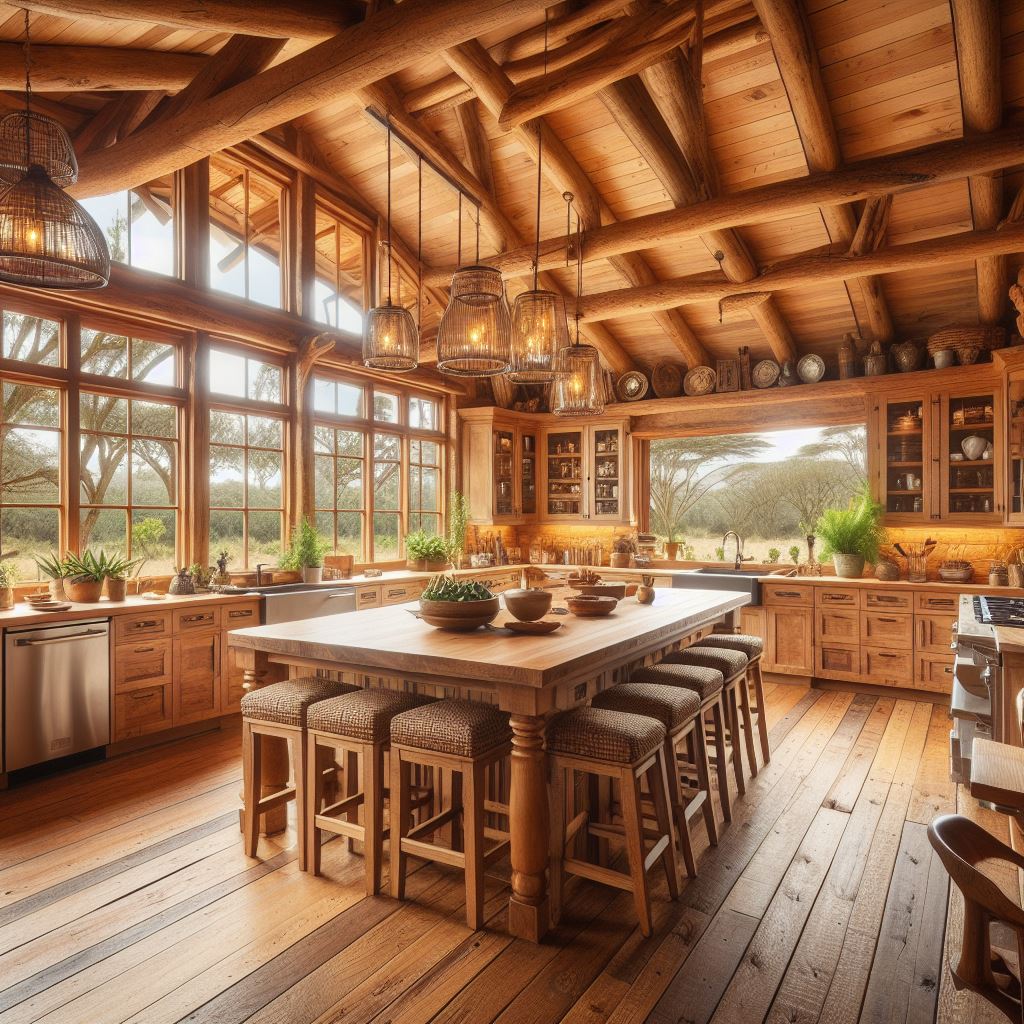The Ultimate Guide to Timber Kitchen in Kenya Leave a comment
Timber kitchens are growing in popularity across Kenyan homes for good reason. Wood infuses spaces with natural warmth and timeless beauty that concrete, steel and laminates simply cannot match.
Crafting a kitchen from high grade wood results in a breathtaking showpiece that familie can cherish for generations while standing up to everyday wear-and-tear.
Beyond aesthetics, timber offers practical strengths like:
- Durability – Hardwoods stand the test of time
- Antibacterial – Natural hygiene qualities
- Sustainable – Renewable and biodegradable
But achieving the perfect bespoke timber kitchen requires careful planning around layout, storage, workflows, materials selection and finishes.
This article will explore the key considerations and components for constructing a stunning and efficient timber kitchen in Kenya.
We’ll cover:
- Key planning factors
- Types of wood and finishes
- Cabinet and countertop options
- Budgeting guidelines
- Recommended vendors
Let’s dive in!
Planning Your Timber Kitchen in Kenya
The foundation for a well-functioning timber kitchen is thoughtful planning and layout. Consider the following core factors:
Space and Dimensions
- Measure overall footprint down to exact room dimensions
- Note any odd angles, ceiling heights, indentations
- Window and doorway placements
This allows planning tailored cabinets and geometry.
Traffic Flow
Map optimal workflows between:
- Cooking zones
- Sinks
- Refrigeration/storage
- Serving spaces
This informs efficient layout to avoid bottlenecks.
Countertops
Determine countertop dimensions needed for:
- Food prep
- Appliances
- Dining
Factor spaced for chopping, moving items, opening appliance doors.
Cabinet Storage
Calculate storage volume needed:
- Dinnerware
- Serving ware
- Cookware
- Dry goods/pantry
Get exact counts of plates, cups etc. to size cabinets.
Appliances
Note placements for:
- Stovetop/range
- Refrigerator
- Dishwasher
- Other – microwave, oven etc.
Lighting
Plan for layered lighting:
- Ambient ceiling
- Task lighting
- Under cabinet
Style Inspiration
Collect inspiration images of:
- Finishes
- Door styles
- Layouts
- Hardware
Proximity Factors
Consider proximity to:
- Plumbing/drainage
- Power outlets
- Supply access
Get input from interior designers, architects and carpenters throughout the planning process.
Types of Wood for Timber Kitchens in Kenya

Timber kitchens primarily utilize two categories of wood:
Hardwoods
Hardwoods come from deciduous trees like oak, maple, cherry, walnut etc.
Benefits:
- Dense, durable – Withstands wear
- Ages beautifully – Enhances over time
- Great stability – Resists shrinking/swelling
- Takes stain well
Drawbacks:
- Generally more expensive
- Can dent if heavily impacted
Top hardwood choices include:
Oak
- Durable, scratches well
- Stains nicely to accent grain
- Rustic to modern looks
Maple
- Very dense, smooth finish
- Lighter wood grain
- Handles abrasions well
- Easy to craft into cabinets
Walnut
- Rich warmer brown tone
- Subtle grain patterns
- Luxurious aesthetic
- Mostly for accent doors/panels
Softwoods
Softwoods derive from conifer trees like cedar, pine and fir trees.
Benefits:
- Cost effective – More affordable
- Workable – Easy to cut, sand and shape
- Uniform appearances
Drawbacks:
- Less durable – Dents and scratches easier
- Not as structurally stable
- Knots/blemishes more likely
When using softwoods, apply veneers, lacquers and surface protections to guard quality. Popular choices include:
Pine
- Affordable option
- Can mimic some hardwood looks
- Prone to dings and residue
Cedar
- Fragrant aroma
- Natural insect/rot resistance
- Too soft for cabinet doors
For cabinetry, opt for higher quality composite boards or solid wood fronts with engineered wood behind.
Get samples to review grains and consistency across boards.
Timber Kitchen Cabinet Options in Kenya
Cabinetry represents the bulk of investment, design impact and labor involved with a timber kitchen. From a quality standpoint, aim for solid hardwood fronts with engineered wood sides/backs.
Primary cabinet options include:
Stock Cabinets
- Factory-built common dimensions
- Limited sizes, configurations
- Melamine or timber fronts
- Affordable but less customization
Custom Cabinets
- Built fully bespoke to order
- Any size/layout imaginable
- Premium solid wood
- Much pricier but truly tailored fit
For cost-effective balance, many combine base stock cabinets with custom uppers tailored to space.
When sourcing cabinets, choices involve:
Door Styles
- Slab – Simple flat panel
- Shaker – Flat center panel bordered by wood
- Raised – Prominent center wood panel
- Glass inset – Glass held by surrounding wood
Finishes/Stains
Consider tone and food preparation suitability:
- Natural oiled look
- Dark walnut
- Bleached
- Painted colors
Get physical samples to judge in home lighting conditions.
Handles & Knobs
Hardware impacts aesthetic greatly:
- Brushed metal
- Black matte
- Antique bronze
- Open backbars
- Industrial pipe
Storage Organization
- Deep pots/pans drawers
- Spice drawers
- Tiered platters
- Pull-out baskets
- Waste sorting
Visit showrooms to get tactile and explore these options.
Selecting Timber Kitchen Countertops in Kenya
The surfaces tying the space together deserve great consideration around materials, functionality and maintenance.
Timber Countertops
Gorgeous integrations of the wood aesthetic:
- Oak, teak, walnut and exotic species
- Can mimic cabinet stain
- Requires thorough seasoning and sealing
- Needs periodic reapplication of sealant
Laminate Countertops
Affordable and practical option:
- High pressure laminate (HPL) finish
- Resists scratches, heat and moisture
- Range of wood-imitating patterns
- Chipping edges can expose substrate
Engineered Stone
Popular composite material:
- Brands like Silestone, Caesarstone
- Quartz particles fused with resin binders = solid surface
- Very durable against scratches/heat
- Stain resistant
- Seamless appearance
Granite
The classic natural stone:
- Premium material requires expert fabrication
- Most stain, scratch and heat resistant
- Lovely speckled stone patterns
- Can chip if severely impacted
- Needs periodic sealing
Concrete
Industrial chic material:
- Stained, polished, stamped finishes
- Heat/scratch-resistant
- Can feel cold under some conditions
- Allow curing time to maximize hardness
Tile
Distinctive accent material:
- Attention grabbing backsplashes/inlays
- Glass, ceramic, terracotta, porcelain
- Coping prevents liquid seepage
Get creative mixing materials like pairing timber with stone surfaces. This allows optimizing aesthetics alongside functionality for prep zones.
Budgeting for a Timber Kitchen
Constructing a tailored high-grade timber kitchen in Keya constitutes a significant investment that yields enjoyment for years to come. For planning purposes when creating initial budgets, expect to spend:
Small Kitchens
5×6 foot prints can start around:
- KES 150,000 – 250,000
Opting for mid range appliances, stock cabinets and laminate counters while relying on existing plumbing and electrical.
Mid Size Kitchens
8×10 layouts with some custom elements land in the range of:
- KES 300,000 – 500,000
Utilizing better grade imported appliances, custom crafted wood cabinetry and composite stone counters.
Large Luxury Kitchens
Sprawling Integrated living room kitchens with premium details can reach:
- KES 1 Million+
With top-tier Dacor/Miele appliances, exquisite custom exotic wood cabinetry, integrated tracking lighting systems, high-end granite surfaces, concealed drainage and electrical.
Cost Breakdown
General component costs include:
- Cabinetry & Counters – 50-60% total
- Flooring – 10%
- Lighting – 5-10%
- Appliances – 10-15%
- Plumbing & Electrical – 5%
- Other – 5-10%
This covers average price ranges but the sky’s the limit for luxury bespoke kitchens. Prepare to pay premiums for exotic imported woods like Black Walnut or Zebrano which can run over KES 15,000 per square foot installed.
Read also:
Sourcing Quality Timber Kitchen Materials
While Nairobi now boasts some competent interior contractors, sourcing exceptional quality exotic woods, specialized European appliances and customized touches often requires ordering from overseas vendors.
To source quality timber kitchen materials in Kenya, you can consider the following options:
- Cameroon Timber Export (cameroontimberexport.com): They are a leading seller of top-grade oak timber and wood logs in Kenya, offering sustainable oak timber with doorstep delivery.
- Wood Products Kenya (woodproductskenya.co.ke): This company provides a wide range of premium quality wood products, including flooring, doors, and kitchens.
- Woodways Kenya Limited (woodwayskenya.com): Known for quality craftsmanship and innovation, Woodways is a preferred choice for all your timber needs, including kitchen materials.
It’s important to note that Kenya faces a timber shortage, and most wood is from government-owned forests or imported from neighboring countries and mass exporters like China or Brazil.
Due to the lack of industrial timber, Kenya has increased imports from countries in the region and outside Africa.
You may want to verify the quality and sustainability of the products offered by these suppliers to ensure they meet your requirements.
Key Takeaways
- Timber kitchens create stunning showpieces that enrich homes through natural beauty and practicality
- Meticulous planning around dimensions, layout and finishes dictate success
- Hardwoods like oak and exotic choices like walnut deliver superior aesthetics merged with strength
- Well-crafted custom cabinetry constitutes the core investment
- Mix timber elements with granite or quartz for best durability
- Expect mid-tier kitchens running 300,000+ KES and luxury versions over 1 Million KES
- Import specialized materials from overseas vendors

